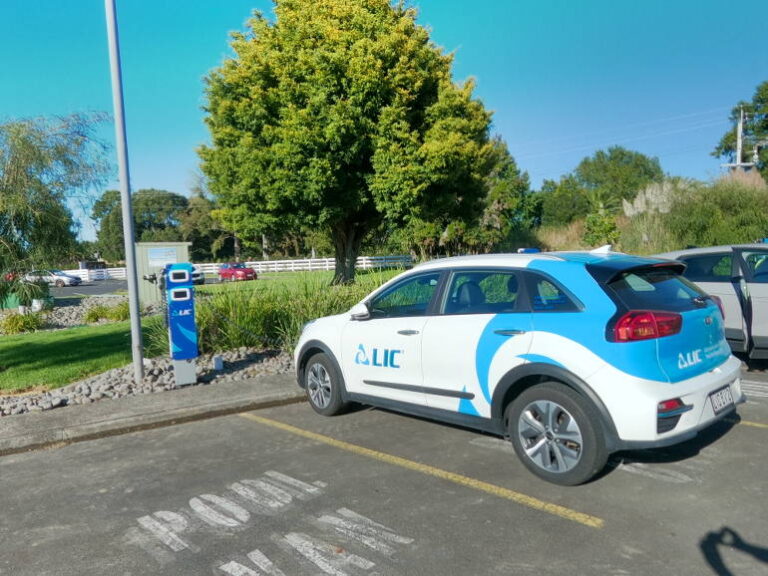“Out of the 60 LIC employees eligible for a company car, 32 went for EVs. The charging stations make it so easy for them and are a massive incentive. In terms of running costs, we have estimated a NZD$240 saving per vehicle per month. As for the cost of the infrastructure, TransNet’s recommendation to avoid the 3-phasing path was the key in this project. This cost saving basically paid for the entire infrastructure.”
– Devon Samuel, Senior Procurement Sourcing Specialist – LIC
The Challenge
LIC, a New Zealand agri-tech and herd improvement co-operative, faced multiple challenges when they decided to introduce electric vehicles (EVs) into their fleet. One of the primary concerns was how to manage home charging for their employees who opted for a company car.
Initially three-phase installations were considered but as homes in New Zealand rely on single phase supply for the most part, upgrading to three phase supply can be a costly and unnecessary solution.
Instead, TransNet were able to suggest a simpler and more cost-effective solution that saw the Power Boost sensor used with the existing single phase supply to achieve the desired outcome. LIC, which has been providing world-leading innovations for the dairy industry for more than a century, also needed an accurate way of tracking the charging costs for reimbursement purposes. The prospect of decommissioning the EV chargers and installing them at another location if an employee left the company was also a concern.
LIC’s main office faced a similar challenge of right-sizing the transformer required to support EV charging and the need to identify each user of the shared chargers. Last but not least, LIC wanted to have the possibility of fast charging to provide better services to visitors and employees.
The Solution
Wallbox partnered with TransNet to work with LIC to provide a comprehensive solution that addressed all of their challenges.
For residential charging, LIC opted for the Pulsar Plus 7.4 kW (singlephase) charger, with power meter sensors to enable Power Boost, which ensured that home charging did not overload their homes. The Power Boost sensor also made it possible for an employee to charge an additional private EV while still charging their company car. The myWallbox app is currently being used to run reports for reimbursement of charging costs. The installation of EV chargers was done using TransNet’s EV ready surface mount bracket, ensuring that if an employee left the company, the Wallbox could be removed, leaving the house EV ready.
LIC’s main office utilised TransNet’s underground EV distribution kitsets, and 26 Wallbox Commander 2 were installed in the main car park, with EV-ready pits installed to double the number of chargers as the fleet of EVs increased. The Commander 2 units made use of the internal 4G connection, with intelligent power management supplying charge to the vehicles without exceeding capacity, eliminating the need for costly transformer upgrades.
Finally, a Supernova 60kW fast charger was installed for visitors convenience and quick top-ups for the LIC fleet.

The Outcome
The comprehensive solution provided by Wallbox, TransNet, and LIC resulted in significant outcomes in terms of CO2 reduction and fuel replacement. In the last 12 months, 21,961.48 Kg Co2 was saved, and 24,553.21 L fuel was replaced. To date 30 Pulsar Pluses have been installed at employees´ homes, in addition to 26 Commander 2 units and a Supernova 60kW public charger. And that´s just the beginning! As more of the fleet is electrified the number will increase.
Almost 1,300 charging sessions were recorded in six months, with 30 different users utilising the charging infrastructure. The solution also addressed all of LIC’s challenges, with dynamic power sharing resulting in better utilisation of existing infrastructure without having to upgrade. Significant savings were also made as a result of not upgrading the transformer.
Overall, the solution provided by Wallbox, TransNet, and LIC resulted in a successful EV charging infrastructure that continues to meet the needs of all stakeholders.
“Too many people apply the petrol station concept into EV Charging, they want to charge as quick as possible. However, the most cost effective and environmentally conscious way is charging as slow as possible within the time frame you have. Applying this mentality can deliver significant cost savings and simplify the complexity of the project.”
– Glenn Inkster, e-Mobility Division, Manager – TransNet NZ Limited






